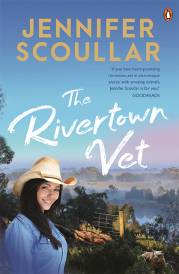Dennis Dugan Jack and Jill
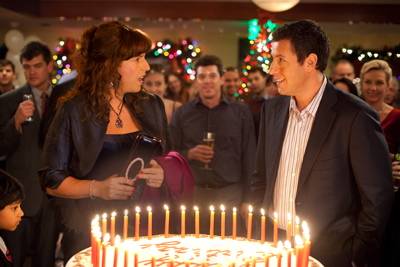
Jack and Jill
Cast: Adam Sandler, Katie Holmes, Al PacinoDirector: Dennis Dugan
Genre: Comedy
Rated: PG
Running Time: 91 minutes
Synopsis: Adam Sandler stars in the title roles of Jack and Jill, the new comedy from Happy Madison. Jack was living an almost perfect life, with the exception of one, annoying constant - his twin sister Jill. Every year he has to tolerate a Thanksgiving visit from his smothering sister, who doesn't take long to turn his life upside down. As the weekend intrusion starts stretching into a month, the siblings fight, tease, and bicker in the way only twins can. When it becomes clear Jill is never leaving, Jack sets into motion several schemes that he hopes will return Jill to where he loves her most - the other side of the country.
Release Date: 1st of December, 2011
About the Film
When you get together with your family for the holidays, everybody has that one family member who drives you crazy. They mean well, and you love them, but still...For Jack, that's his sister - his twin sister - Jill. Growing up, their lives were incredibly intertwined. But ever since Jack moved away, they have moved in different directions. Jack has become a highly motivated and successful ad executive in L.A., while Jill was the one who stayed back east and took care of their parents. Now, they see each other only once a year, at Thanksgiving, when Jill comes to L.A. for a visit. Time and distance have taken a toll on their relationship - and now Jack finds himself enduring Jill's annual visit, rather than enjoying it.
Still, it's just a couple of days, right? Wrong. Jack and Jill get off on the wrong foot - just like always - and the only way Jack can make things right is to ask Jill to stay on through Hanukkah, giving her some time to enjoy everything L.A. has to offer, from game shows to horseback riding. Still, Jack isn't exactly pleased that his sister is extending her trip...
And adding to Jack's stress is the fact that things aren't going all that well at his ad agency. His biggest client, Dunkin Donuts, is demanding that Jack deliver Al Pacino to perform in a new Dunkaccino commercial. Jack wonders how in the world he is going to get Al Pacino - does he even do commercials? - and his quest is intensified when he finds out that the famous actor is having a nervous breakdown and losing his mind. Having played one too many roles, the actor is starting to confuse reality with the parts he is playing and is acting out in some increasingly erratic ways.
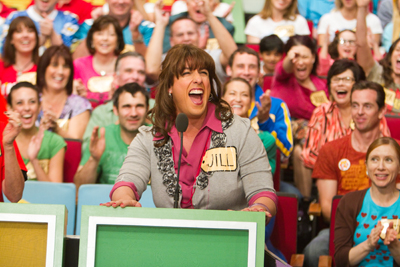 When Jack takes Jill to see the Lakers, he approaches Al Pacino about the commercial, but is stunned when Al Pacino is much more interested in talking to Jill. It turns out that Jill reminds Al Pacino of everything he left behind - his boyhood home in the Bronx, his childhood - and for Al Pacino, who is preparing to play Don Quixote on stage, something clicks. Because he's having trouble with reality, suddenly, Jill isn't Jack's wacky sister? she's Dulcinea, Don Quixote's idealised romantic love - and Al Pacino must conquer her affections to realise his quest.
When Jack takes Jill to see the Lakers, he approaches Al Pacino about the commercial, but is stunned when Al Pacino is much more interested in talking to Jill. It turns out that Jill reminds Al Pacino of everything he left behind - his boyhood home in the Bronx, his childhood - and for Al Pacino, who is preparing to play Don Quixote on stage, something clicks. Because he's having trouble with reality, suddenly, Jill isn't Jack's wacky sister? she's Dulcinea, Don Quixote's idealised romantic love - and Al Pacino must conquer her affections to realise his quest. Trouble is, Jill isn't interested. But Al Pacino will not be brushed aside so easily. Inviting himself to Jack and Jill's surprise birthday party, he sweeps Jill off her feet and takes her for a private party at his home - but Jill still isn't biting, which only inflames Al Pacino's passion (and insanity). It's not clear who's more upset - Jill, from the experience, or Jack, who thinks his chance to get Al Pacino could be over, or Al Pacino, who is completely losing it for Jill.
For Jack, now the shoe is on the other foot: he has to try to convince Jill to extend her trip even further and give Al Pacino one more shot. It's a move that sets in motion a wild, outrageous series of events that reveals to Jack who the most important people in his life are - and have always been.
About the Production
Director Dennis Dugan re-teams with Adam Sandler for the eighth time on the comedy Jack and Jill. "What I found interesting was that somewhere partway through the production I thought of Adam Sandler as playing Jack, but I thought of Jill as if she were her own person. Adam Sandler didn't walk around off-camera acting like Jill, but after a while, it was as if Jill was a woman we hired who happened to look remarkably like Adam Sandler."In the film, Adam Sandler plays Jack, an advertising executive who is one commercial away from hitting the big time - or, if the deal falls through, unmitigated disaster. Into this turmoil comes his twin sister, Jill - who always makes things more complicated than they need to be.
"I knew Adam Sandler would have no problem playing Jill. The part he worked at was to play Jack," says Steve Koren, who co-wrote the screenplay with Adam Sandler. "Jack's the kind of guy who's a little bit on edge - he's had to work to make that guy different from who he really is."
While writing the film with Adam Sandler, Steve Koren found some interesting things. "Some twins actually create their own language when they're little kids, so we invented a special, private language that only Jack and Jill speak," he says. "We also found out that twins have a bond that is a lot stronger than some siblings, so we tried to incorporate as much of that as possible."
Playing the dual role required an ingenious sense of timing from Adam Sandler. "Part of the joke was that Jack and Jill would do the exact same things at the exact same time," Steve Koren explains. "What that meant, of course, was that Adam Sandler would do the scene once, and then he'd redo it as the other character. It was almost like a dance, a ballet Adam Sandler had to have incredible focus and perfect timing. It was pretty incredible to watch."
Describing the character and the plot of the film, Steve Koren explains, "Jill had only two constants in her life - taking care of her parents and the love of her bird, Poopsie. She's sacrificed her personal life. When she comes to visit Jack for the holidays and won't leave, Jack tries to help her find a guy - a guy who he hopes will get her out of his house."
Of course, nothing goes as planned. Instead of an internet date, Jill gets an impossibly unlikely suitor. In the film, Jack needs Al Pacino to agree to do a commercial - and if he can't get Al Pacino, Dunkin Donuts will take their business elsewhere. Just as he's wondering what he's going to do, who should fall for Jill but the Oscar®-winning actor himself. Just one catch - in the movie, the character of Al Pacino is suffering from a nervous breakdown.
For the role of Al Pacino, the filmmakers decided to get Al Pacino. "In the movie, Al Pacino isn't really playing himself - he's playing an obsessive actor who has gone a bit off the deep end and is losing his marbles," says Steve Koren. "So, when he falls for Jill, he goes overboard. He's willing to go to any length to get the girl. The trouble is, Jill's just not all that into him. She knows more about 'American Idol' than she does about Al Pacino."
Al Pacino plays the character in a way that is very different from the man he is in real life. "He's an actor who's losing control," says Al Pacino. "He has had an overload of work and it's starting to take hold of him and affect his mental capacity. He's clearly in the middle of a breakdown. That's the track I've taken in order to play myself as somebody else - it's all heightened and exaggerated as to make it believable in a comedy. However, I tried to keep it real so that the madness is real."
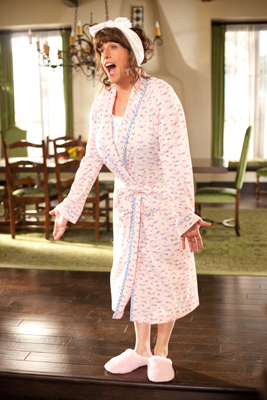 In the movie, the character of Al Pacino is starting to lose his grip on reality. He has been mulling an offer to play Don Quixote in "Man of La Mancha" on Broadway - and when he meets Jill, he endows himself and Jill with characteristics of the characters. "In 'Man of La Mancha,' Don Quixote is a madman who believes himself to be a knight, and he believes Dulcinea to be a princess, even though she's an ugly peasant. He falls madly in love with her by endowing her with virtues she doesn't really possess," Al Pacino explains. "When my character meets Jill, he does the same thing. She becomes his Dulcinea. In a sense, my character unconsciously uses her as a tool to find out if he indeed wants to play the part of Don Quixote. He gives Jill all the traits of the character Dulcinea so he can rehearse it, try it out, and see if it fits. He doesn't even know he's doing it, but there's method in his madness."
In the movie, the character of Al Pacino is starting to lose his grip on reality. He has been mulling an offer to play Don Quixote in "Man of La Mancha" on Broadway - and when he meets Jill, he endows himself and Jill with characteristics of the characters. "In 'Man of La Mancha,' Don Quixote is a madman who believes himself to be a knight, and he believes Dulcinea to be a princess, even though she's an ugly peasant. He falls madly in love with her by endowing her with virtues she doesn't really possess," Al Pacino explains. "When my character meets Jill, he does the same thing. She becomes his Dulcinea. In a sense, my character unconsciously uses her as a tool to find out if he indeed wants to play the part of Don Quixote. He gives Jill all the traits of the character Dulcinea so he can rehearse it, try it out, and see if it fits. He doesn't even know he's doing it, but there's method in his madness." In addition, Jill represents something that the character of Al Pacino feels he has lost. "Our character of Al Pacino is at a crossroads," says Dennis Dugan. "He's kind of lost in Los Angeles. The thing that's missing in life is who he used to be - a sense of home and roots. Suddenly, here's a woman who comes to him at the height of his fame and reminds him of who he used to be. He needs to go back to his home, and he thinks Jill is his ticket."
"I love the idea of playing an older movie star, clinging, trying to get back to what it was that made him do this thing in the first place," Al Pacino continues. "My character is a guy who just wants to go back home, wants to be simple again, but will never be able to be that way again. And no matter how crazy he is, his instincts are still working as an actor - if he engages her in the same way Don Quixote engages Dulcinea, he can find out if he can really play the part in 'Man of La Mancha.' It's subtle and unusual, but this is the actor's journey out of madness."
Dennis Dugan says that working with Al Pacino was, of course, a completely unique experience. "I didn't know what to expect - he's obviously a serious actor - but he embraced the insanity," says Dennis Dugan. "He played his version of Al Pacino in a truly brilliant way. He's a genuinely nice guy and he had a terrific attitude about the whole thing."
Naturally, the real Al Pacino provided exactly what you'd expect: a tremendous actor, having the time of his life. "Al was at the top of his game - Adam Sandler would throw something at him, and Al Pacino would catch it and fire it right back," says Dennis Dugan. "He embraced the way we work, which I think is different from the way most sets work. But Al was never thrown off by any of it - he stood in there and hit it as hard as he could."
The film's cinematographer, Dean Cundey, says that the film changes very slightly in tone when Al Pacino is on the screen. "Like a lot of comedies, we wanted a bright and high-key look - as opposed to something moody or dark - but in the Al Pacino scenes, we had an opportunity to bring more of an edge," he explains. "Al Pacino is identified with many of his darker characters, so I thought it might be interesting to inject a little bit of that into his scenes. For example, for the reveal of Al Pacino in the restaurant, I took a cue from the way we've discovered Al Pacino in the past and put him in dark silhouette, with smoke wafting from his cigar and some light across his eyes and face in a darkened room. It's a fun moment in the film."
Katie Holmes joins the cast as Erin, Jack's wife and mother to their two children. "She's a very busy wife and mother," Katie Holmes explains. "When Jill comes to town and creates a lot of mayhem within the family, she's the one who's trying to keep it all together."
"It was wonderful to see Adam Sandler transform into Jill," she continues. "As a woman, it was nice to have conversations with a man about shaving legs, how pantyhose and heels feel, and all of the tougher parts about being a woman. Adam Sandler was a great sport - it was really, really fun."
One of Mexico's top comics, Eugenio Derbez, joins in the fun as Felipe, Jack's gardener, who genuinely likes Jill for who she is. "Felipe thinks he's funny - he's always cracking jokes, then saying, 'I'm kidding, I'm kidding.'" Eugenio Derbez was up for the challenge to be funny in English, even though his first language is Spanish. "You memorise the lines and get the language under control, but you still have to deliver the joke - it's not just saying it in English. And the delivery might be very different in Spanish and in English. Finding the tone is the challenge."
It turns out that Adam Sandler isn't the only actor playing a dual role as a man and a woman: Eugenio Derbez also plays Felipe's grandmother. "Yes, that's me, too," he says. "They asked if I had a relative who could do the scene, and I said no, but I could play my own grandma. I play a lot of different characters on my TV shows - so they saw my reel, and that was that. It was a lot of fun to do, except for the makeup. The process takes 3p or 4 hours, and they put glue all over my face - my beard, too. I had five different prosthetics on my head and face. I'd still be finding glue three days after shooting."
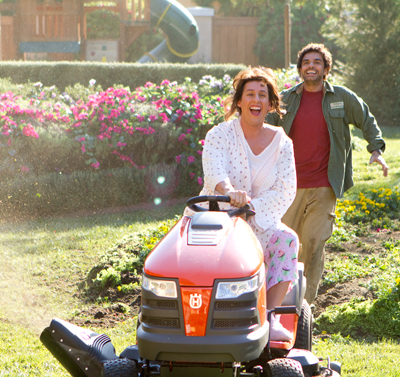 From his experience on his shows in Mexico, Eugenio Derbez had ample experience performing sketch comedy, which, of course, is where Adam Sandler and his crew at Happy Madison got their start. "That made him a good choice for the Adam Sandler squad," says Dennis Dugan. "He gets the whole thing we do - we try whatever comes up as we shoot. We stay on our toes - somebody throws it to you, and you throw it back. He's funny - he's just funny."
From his experience on his shows in Mexico, Eugenio Derbez had ample experience performing sketch comedy, which, of course, is where Adam Sandler and his crew at Happy Madison got their start. "That made him a good choice for the Adam Sandler squad," says Dennis Dugan. "He gets the whole thing we do - we try whatever comes up as we shoot. We stay on our toes - somebody throws it to you, and you throw it back. He's funny - he's just funny." Also joining the cast are Elodie Tougne and Rohan Chand, who play Jack and Erin's kids, Sofia and Gary. Allen Covert, Nick Swardson, Valerie Mahaffey, and Geoff Pierson round out the cast.
Transforming Jack into Jill
For the behind-the-camera crew, the primary challenge of the film was in making Adam Sandler into two characters. The primary task went to makeup department head Ann Pala, hair department head Thomas Real, and costume designer Ellen Lutter.
Ann Pala and Thomas Real went through dozens of hair styles, textures, colors, and lengths (short, curly, and long), various nail colors and lengths, lip colors, skin tones, lashes, and teeth, all in different combinations. Working with three Adam Sandler look-alikes, they created a number of different options for the filmmakers to choose from.
"Adam Sandler had played a girl in various sketches on 'Saturday Night Live,'" says Ann Pala, indicating that they had some idea of what might work with the actor. "The key factors in giving him feminine features were his eyes, cheeks, teeth, and bangs. We used nine different makeup skin tones to highlight and conceal."
It was key to the filmmakers to try to create a real character in Jill. "Adam Sandler's not playing a man playing a woman he's playing a woman," notes Ellen Lutter. "It wasn't a question of drag - we wanted to create a real woman, with specific features, character traits - it had to be genuine and natural. On the other hand, we were able to have a little fun because part of the character is that she looks exactly like her brother. We had the room to play and have some fun with Adam Sandler's muscles and masculine demeanor - Jill is not a hyper-feminine character."
Ellen Lutter says that when it came to Jill's clothes, "Adam Sandler likes to be very comfortable, but being comfortable has nothing to do with being a woman. We tapped into the lightness of the character - and that's where we had all our fun. Adam Sandler would always say, 'I know you guys like Jill better,' and it was true!"
Still, dressing Adam Sandler as Jill wasn't as simple as putting him in a dress. "Everything had to be manipulated - whether it was adding a detail around the neckline, or something with the arms, or working with the waist to build some hips. Everything had to be altered and adjusted to play with the proportions. It's not like the clothes were just hanging around."
How They Did It
To handle technical challenges of filming Adam Sandler opposite himself, the filmmakers turned first to director of photography Dean Cundey, the cinematographer who shot Who Framed Roger Rabbit, The Parent Trap, Back to the Future, and Jurassic Park.
"When an actor plays two characters in the frame at the same time, there are a lot of tricky things that occur - tricky, because the process usually requires you to do a shot with one character in the frame and then repeat the shot with the other character also in the same frame," Dean Cundey explains. "Sometimes, it's a fairly simple process, as simple as a split. In those shots, the camera doesn't move. In those, you film it twice, with the actor playing one character on one side of the frame, and then again, playing the other character on the other side of the frame. Then you go into the computer and put them together, almost like you're taking two photographs and cutting them in the middle and pasting them down."
From those simple shots, the process can get increasingly complicated. "We'll move the camera, have them touch each other, hand each other objects - it's a great way to keep the audience engaged," Dean Cundey continues.
Dean Cundey describes a typical shot: "We'd shoot Adam Sandler as Jack. Then he'd go and get made up as Jill we'd relight the set and we'd have to make sure that the lighting was right for where Adam Sandler would be standing as Jill. Adam Sandler would come in and we'd give him a little ear bud, so he could hear his performance as Jack, which he'd just done. We had a monitor set up so he could see what Jack was doing. Dan DeLeeuw, the visual effects supervisor, would make sure that the shots were going to work. The motion control technicians made sure we were getting the exact camera movement over and over again. Finally, the on-set compositor could put it together as we did it - show us how it's going together so we could evaluate it and judge it. It was a very team-heavy process."
"We used a computer-controlled camera - the computer is programmed to do the exact same move multiple times," says Dan DeLeeuw. "We could shoot once for Jack and do the same move again with Jill." A good example, he notes, is the scene in which Al Pacino falls for Jill at a basketball game. "Not only do you have Jack and Jill, but the basketball players and the crowd behind them. As the setting gets bigger, so does the difficulty."
It fell to Dan DeLeeuw to create the illusion that Adam Sandler really does have a twin sister. "These effects took a lot of planning, right from the storyboard stage - but it's also a comedy, so we all had to stay on our toes," he says. "For many shots, we'd shoot Adam Sandler with a body double for Jill - the double would wear a green hood over his head, which we could remove later and replace with Adam Sandler, as Jill."
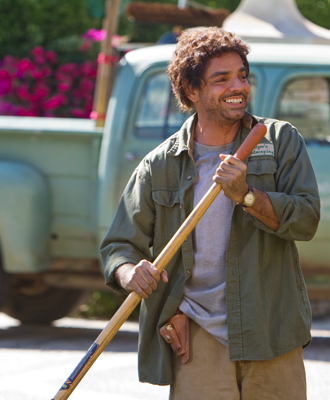 Dean Cundey explains how he worked in tandem with Dan DeLeeuw: "The on-set process is the gathering of the pieces of the puzzle - the mosaic that is later put together by the compositors and post-production team. I had to make sure that the pieces are the right pieces - as the audience gets more and more sophisticated, you can't do anything simply. You have to give them the pieces so they can do something interesting and unique."
Dean Cundey explains how he worked in tandem with Dan DeLeeuw: "The on-set process is the gathering of the pieces of the puzzle - the mosaic that is later put together by the compositors and post-production team. I had to make sure that the pieces are the right pieces - as the audience gets more and more sophisticated, you can't do anything simply. You have to give them the pieces so they can do something interesting and unique." Dean Cundey says that the production had a great asset in Adam Sandler. "As we got through the process, Adam Sandler learned more and more about how to do what we wanted to do, and he was a fast learner," says Dean Cundey. "The great thing about Adam Sandler and his creative process is that every new shot is an invention. We'd rehearse a shot and have a very good idea of what we wanted to do, but everything was subject to rehearsal and seeing how it played. The coolest thing about this production was being able to think on your feet - there'd be a new idea, and it would be up to Dennis Dugan, me, and the assistant director to figure out how we were going to do it."
On the Cruise
In the film, the Sadelsteins go on a family vacation during the holidays every year this year, they've booked a cruise on Royal Caribbean's Allure of the Seas, the largest cruise ship in the world. "We were lucky enough to have the timing of our movie coincide with the launching of the ship," says Dennis Dugan. "They were building the ship in Norway while we were prepping the movie. We contacted them and they were very happy to do business with us. We sent a couple of electricians over to Norway to lay the cables and figure out all of our electrical hookups, so when the ship got here we'd be ready to go. We met them in Florida, and during their trial runs, when they were still getting ready for the paying passengers, we were able to shoot on the ship for 10 days."
"It is truly a five-star hotel floating on the water," says production designer Perry Andelin Blake. "We had the opportunity to film in the coolest parts of the ship. At the bow of the ship, we made a restaurant. The biggest challenge was to decorate the ship for Christmas - the ship is 1,000 feet long, and in some shots, you can see 500 feet and two pools and three or four levels. Of course, we had to have holiday decorations on the whole thing. We bought truckloads of decorations at a store in Fort Lauderdale - 1500 feet of garland with sparkly lights, seven Christmas trees from 8 to 16 feet tall, 15 toy soldiers, 10 toy kings? it was just incredible."
"We knew ahead of time that working on a cruise ship can be confining the spaces are smaller," says the director of photography, Dean Cundey. "When you think about it that way, you realise why cruise ship scenes in movies are classically shot on sound stages." Dean Cundey explains that there were two reasons that the production was able to use the real thing: "First, The Allure of the Seas is the largest cruise ship in the world, so the space issue isn't such an issue, and second, since this was not a public cruise, we'd essentially have the ship to ourselves."
But while there were certain challenges to shooting on a cruise ship, there were also advantages. Dennis Dugan says, "I would say it wasn't any more difficult than any other location. In fact, it was interesting - as we were filming on the bow of the ship, as the day would go by the sun would move. Well, because they ship didn't have any paying customers and no real destination, we were able just to have them turn the ship, so the sun would stay the same all day for us. There's no location in the world where you can get that kind of accommodation with the sun."
"The captain did one very long, slow turn - one degree every six minutes," explains Dean Cundey, "So the sun stayed in exactly the same spot with reference to the ship. Another day, we had a bit of overcast weather off the coast of Florida. But that was no problem - the captain just moved the ship."
Such careful planning was necessary to make the illusion that Jack and Jill are actually separate people work, explains Dan DeLeeuw, the visual effects supervisor. "Jack and Jill jump rope, Double Dutch, with a crowd surrounding them," he says. "You have the ocean behind them and the sun going down - and, obviously, we had to shoot it twice to get both sides. That was a challenge - to shoot a twin movie on the back of a ship while the sun was going down."
That said, Dan DeLeeuw was up to the challenge. After all, filming it all on a green screen just wouldn't have been the same. "The boat has an orange deck, so you've got a nice orange bounce that reflects off the actors. You've got the open sky blue skies - you just don't get that same kind of lighting in a green screen."
The Production Design
Much of the film is about contrasting Jack and Jill - highlighting their superficial differences to underscore all of the ways that deep down they are exactly alike. One way the filmmakers were able to do that was to show the twins living very different lives - Jack in his Brentwood mansion and Jill in her spartan Bronx home.
"We made them two extremes," says production designer Perry Andelin Blake, who has worked on countless Adam Sandler projects. "Jack's house is big, beautiful, and open, with a great back yard, a swimming pool, and greenery and trees and flowers everywhere. The rooms are huge, light, spacious, and comfortable. At the end of the film, you see Jill's house in the Bronx - she drives up in her little Honda Civic, parks by the dirty snow, and walks up to a tiny, cramped house with stuff everywhere."
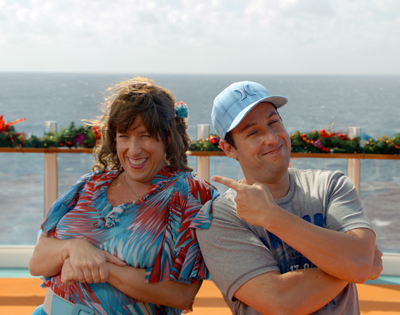 For the artwork on the walls of the Sadelsteins' home, the filmmakers got personal with their inspiration. "Artwork is so subjective and people's opinions of it are so varied - we asked ourselves, what kind of artwork would he have on the walls of his house? Our director, Dennis Dugan, is also a photographer, and we came up with the idea to use his pictures for the artwork at Jack's house. Jack is an ad guy we thought an ad guy would have good taste, cool taste, and he might have a collection of art photography, as opposed to other kinds of art. Dennis Dugan pulled about 50 pictures from his years of photography and we started going through it - photographs from the 60s and 70s, from his travels in Europe and other places in the world. Not only was there a variety that we could use, but we could tweak it in ways that it looked more like a collection of a number of different photographers - for example, we could tweak a photograph in Photoshop to make it really colorful, or print it on canvas or fabric and make it into a hanging, or print on slick paper and mount it, or frame it. They contrast nicely with the house - this old Spanish-style house that has been refurbished and made new for this family - they give it a very contemporary feel and it doesn't feel stuffy at all."
For the artwork on the walls of the Sadelsteins' home, the filmmakers got personal with their inspiration. "Artwork is so subjective and people's opinions of it are so varied - we asked ourselves, what kind of artwork would he have on the walls of his house? Our director, Dennis Dugan, is also a photographer, and we came up with the idea to use his pictures for the artwork at Jack's house. Jack is an ad guy we thought an ad guy would have good taste, cool taste, and he might have a collection of art photography, as opposed to other kinds of art. Dennis Dugan pulled about 50 pictures from his years of photography and we started going through it - photographs from the 60s and 70s, from his travels in Europe and other places in the world. Not only was there a variety that we could use, but we could tweak it in ways that it looked more like a collection of a number of different photographers - for example, we could tweak a photograph in Photoshop to make it really colorful, or print it on canvas or fabric and make it into a hanging, or print on slick paper and mount it, or frame it. They contrast nicely with the house - this old Spanish-style house that has been refurbished and made new for this family - they give it a very contemporary feel and it doesn't feel stuffy at all." Perry Andelin Blake also had the chance to design the living room of a Majorcan castle - but his favorite set, perhaps, is the one for the Dunkin' Donuts commercial that closes the film. "It looks exactly like a Dunkin' Donuts store - we got really into it, down to the details, the counters, the signage, even the actual doughnuts from Dunkin' Donuts. And then the camera pulls back and it turns into a fantastic Busby Berkeley scene with Al Pacino in a tuxedo and, people singing and dancing, a shiny, black floor and colorful lighting. That was really fun."
MORE
Copyright © 2001 - Girl.com.au, a Trillion.com Company - All rights reserved. 6-8 East Concourse, Beaumaris, Vic 3193, Australia.




